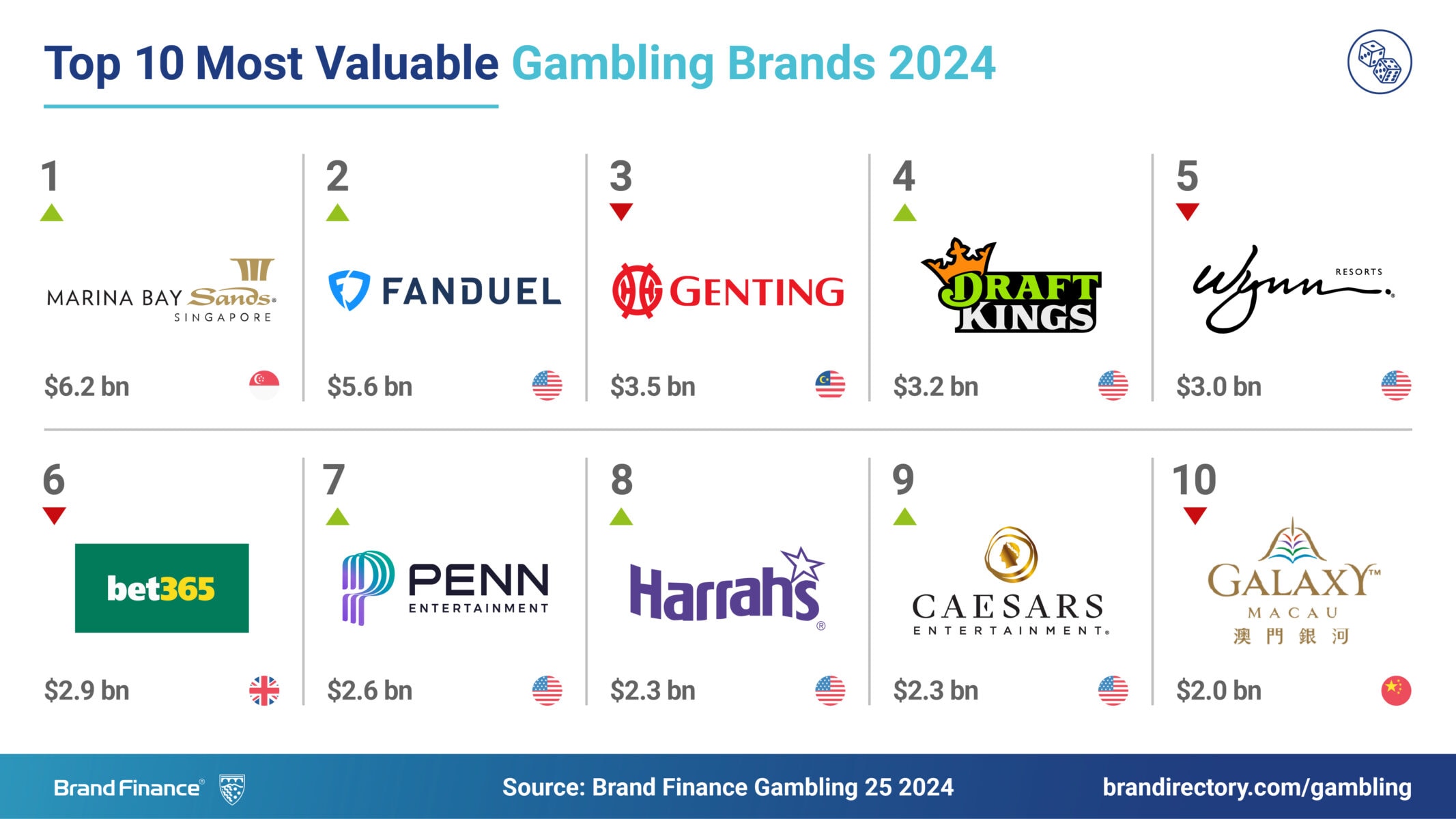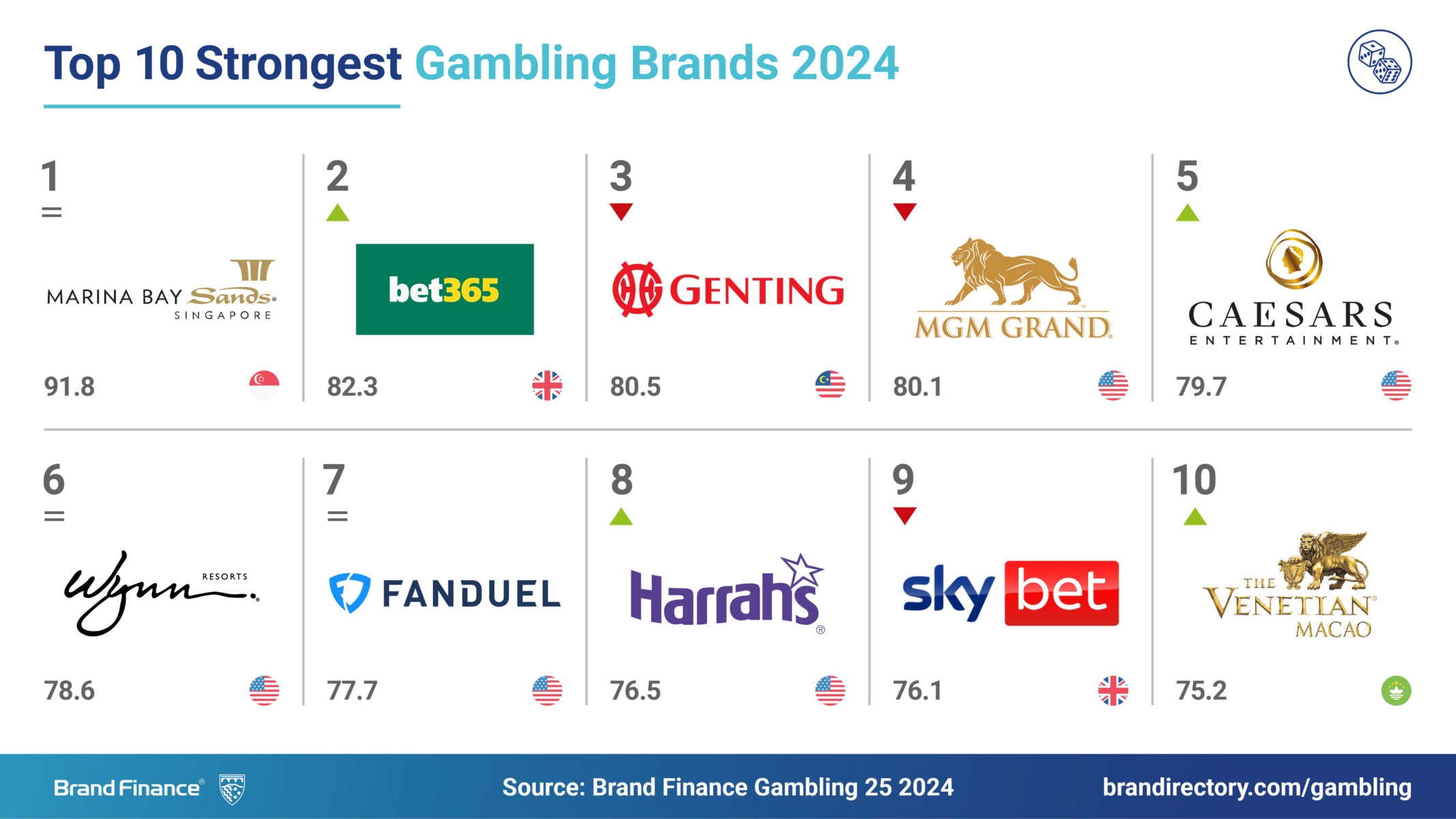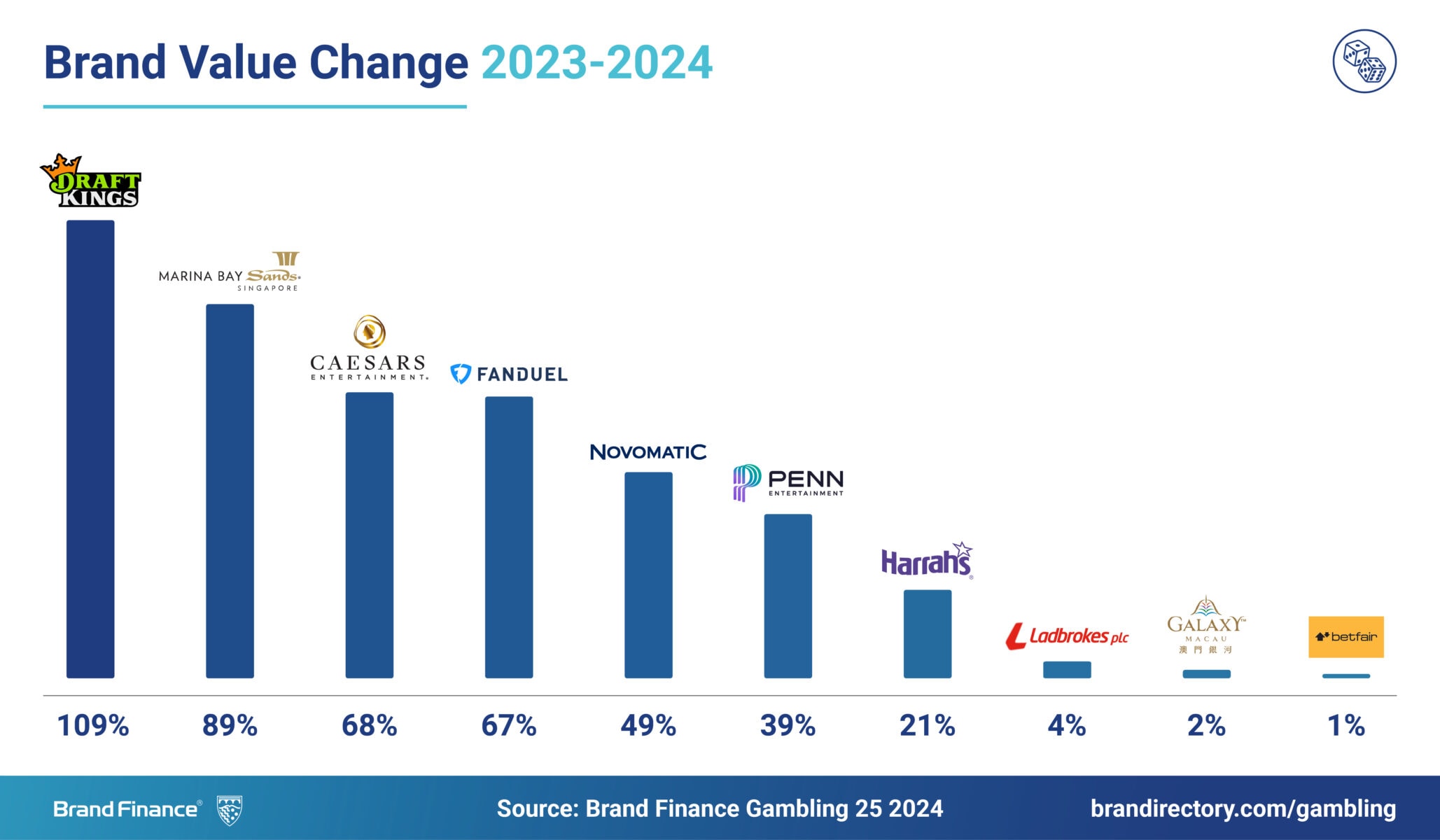Den vollständigen Brand Finance Gambling 25 2024 Bericht finden Sie hier
Marina Bay Sands erklimmt neue Höhen: Mit einer Bewertung von 6,2 Milliarden Dollar ist sie jetzt die weltweit wertvollste Glücksspielmarke.
Diese Führung wird durch einen Anstieg des Markenwerts um 89 % auf 6,2 Milliarden USD und eine Verbesserung der Markenstärke von 86,83 auf 91,81 hervorgerufen, womit Marina Bay Sands eine der wenigen Marken in dieser Branche ist, die ein AAA+-Rating erreicht. Marina Bay Sands hat sich von seiner früheren Position als 5. wertvollste Glücksspielmarke zur weltweiten Nummer 1 entwickelt.
"Die einzigartige Positionierung von Marina Bay Sands, die seine Rolle als ikonisches Wahrzeichen mit seinem kommerziellen Erfolg verbindet, zeichnet es innerhalb der Branche aus. Dieser doppelte Aspekt der Marke trägt zu ihrer ausgeprägten Markenidentität bei."
Henry Farr, Associated Director bei Brand Finance
DraftKings hat sich als die am schnellsten wachsende Marke in der Glücksspielbranche herauskristallisiert und seinen Markenwert auf 3,2 Mrd. USD mehr als verdoppelt. Dieses Wachstum hat DraftKings vom 13. auf den 4. Platz in der Markenrangliste springen lassen.
Dieses Wachstum ist in erster Linie auf die starke Leistung des Sportwetten- und iGaming-Produktangebots zurückzuführen, das durch effektive Kundengewinnungs- und -bindungsstrategien, die Expansion in neue Gerichtsbarkeiten und verbesserte Werbeinvestitionen in diesen Bereichen gestützt wird.
Durchweg gute Karten zeigen sich im internationalen Spiel bei dem österreichischen NOVOMATIC AG-Konzern.
„Die Marke NOVOMATIC ist die einzige und am schnellsten wachsende Marke aus Kontinentaleuropa und konnte sich im Ranking von Platz 24 im Vorjahr auf Rang 17 der wertvollsten Glücksspielemarken aufschwingen.“
konstatiert Ulf-Brün Drechsel, Country Director DACH bei Brand Finance
Der Markeneigner von NOVOMATIC und Admiral ist sowohl als Produzent wie auch Betreiber einer der größten Gaming-Technologiekonzerne der Welt. Die im Jahr 1980 gegründete Unternehmensgruppe verfügt über Standorte in über 50 Ländern. Exportiert werden Glücksspielequipment, Systemlösungen, Lotteriesystemlösungen und Dienstleistungen in rund 100 Staaten. Der Konzern betreibt rund 2.100 eigene elektronische Automatencasinos und Spielbanken sowie über Vermietungsmodelle insgesamt rund 214.000 Gaming Terminals und Video Lottery Terminals (VLTs).
„Durch ihre internationalen Tochtergesellschaften ist der NOVOMATIC AG-Konzern als Full Service-Anbieter quasi in allen relevanten Segmenten der Glücksspielindustrie tätig und bietet somit ein margenträchtiges und nahezu lückenloses Omni-Channel-Produktportfolio für Partner und Kunden weltweit. Das drückt sich nunmehr auch in einem stetig steigenden Wachstum im Markenwert da. „erläutert Ulf-Brün Drechsel den Erfolg der Marke.
Aktuell konnte die Marke NOVOMATIC damit um fast fünfzig Prozent zum Vorjahr an Markenwert zulegen und etabliert sich in die Top Twenty der globalen Gambling Brands.
FanDuels Glückssträhne: Sprunghafter Anstieg des Markenwerts um 67 % auf 5,6 Milliarden US-Dollar, und Sicherung des zweiten Platzes in der Glücksspielbranche
Caesars hat in diesem Jahr ein bemerkenswertes Wachstum erzielt: Der Markenwert stieg um 68 % auf 2,2 Mrd. USD. Dieser bedeutende Fortschritt hat Caesars vom 16. auf den 7. Platz in der Branchenrangliste katapultiert. Auch der Stärke- Index der Marke hat sich deutlich verbessert: von 66,45 mit einem AA- Rating auf 79,72, was einem AAA- Rating entspricht. Dieses Wachstum ist ein Beleg für die strategischen Fortschritte von Caesars und seine zunehmend starke Position im Glücksspielsektor.
FanDuels Glückssträhne: Sprunghafter Anstieg des Markenwerts um 67 % auf 5,6 Milliarden US-Dollar, und Sicherung des zweiten Platzes in der Glücksspielbranche
FanDuel verzeichnete ebenfalls ein beträchtliches Wachstum: Der Markenwert stieg um 67 % auf 5,6 Mrd. USD. Dieser bemerkenswerte Anstieg hat FanDuel vom 4. auf den 2. Platz in der Branchenrangliste befördert und spiegelt die wachsende Bedeutung und den Einfluss des Unternehmens im Glücksspielsektor wider. Das Umsatzwachstum von FanDuel, ein Schlüsselfaktor für den steigenden Markenwert, wird auf der Grundlage der von der Muttergesellschaft Flutter veröffentlichten H1- und Q3-Berichte geschätzt
Flutter, die Muttergesellschaft von FanDuel, rechnet mit einem beträchtlichen langfristigen Wachstum für ihr US-Geschäft.
bet365 hat mit Gegenwind zu kämpfen: der Markenwert sinkt auf $2,8 Milliarden trotz verbesserterm Markenstärke - Index.
bet365, der Spitzenreiter des letzten Jahres, hat einen deutlichen Einbruch des Markenwerts zu verzeichnen. Der Wert der Marke sank um 29 % auf 2,8 Mrd. USD, was zu einem Abstieg vom 1. auf den 6. Trotz dieses Rückgangs des Markenwerts konnte bet365 eine Verbesserung der Markenstärke verzeichnen und stieg von 78,42 auf 82,32.
Der Hauptgrund für den Rückgang des Markenwerts von bet365 wird auf einen Rückgang der Betriebsgewinne zurückgeführt. Während die Einnahmen des Unternehmens nur um 2 % zurückgingen, brach der Gewinn dramatisch ein und sank zum Vorjahr um satte 90 %.
Den vollständigen Brand Finance Gambling 25 2024 Bericht finden Sie hier



Brand Finance is the world’s leading brand valuation consultancy. Bridging the gap between marketing and finance, Brand Finance evaluates the strength of brands and quantifies their financial value to help organisations make strategic decisions.
Headquartered in London, Brand Finance operates in over 25 countries. Every year, Brand Finance conducts more than 6,000 brand valuations, supported by original market research, and publishes over 100 reports which rank brands across all sectors and countries.
Brand Finance also operates the Global Brand Equity Monitor, conducting original market research annually on 6,000 brands, surveying more than 175,000 respondents across 41 countries and 31 industry sectors. By combining perceptual data from the Global Brand Equity Monitor with data from its valuation database — the largest brand value database in the world — Brand Finance equips ambitious brand leaders with the data, analytics, and the strategic guidance they need to enhance brand and business value.
In addition to calculating brand value, Brand Finance also determines the relative strength of brands through a balanced scorecard of metrics evaluating marketing investment, stakeholder equity, and business performance, compliant with ISO 20671.
Brand Finance is a regulated accountancy firm and a committed leader in the standardisation of the brand valuation industry. Brand Finance was the first to be certified by independent auditors as compliant with both ISO 10668 and ISO 20671 and has received the official endorsement of the Marketing Accountability Standards Board (MASB) in the United States.
Brand is defined as a marketing-related intangible asset including, but not limited to, names, terms, signs, symbols, logos, and designs, intended to identify goods, services, or entities, creating distinctive images and associations in the minds of stakeholders, thereby generating economic benefits.
Brand strength is the efficacy of a brand’s performance on intangible measures relative to its competitors. Brand Finance evaluates brand strength in a process compliant with ISO 20671, looking at Marketing Investment, Stakeholder Equity, and the impact of those on Business Performance. The data used is derived from Brand Finance’s proprietary market research programme and from publicly available sources.
Each brand is assigned a Brand Strength Index (BSI) score out of 100, which feeds into the brand value calculation. Based on the score, each brand is assigned a corresponding Brand Rating up to AAA+ in a format similar to a credit rating.
Brand Finance calculates the values of brands in its rankings using the Royalty Relief approach – a brand valuation method compliant with the industry standards set in ISO 10668. It involves estimating the likely future revenues that are attributable to a brand by calculating a royalty rate that would be charged for its use, to arrive at a ‘brand value’ understood as a net economic benefit that a brand owner would achieve by licensing the brand in the open market.
The steps in this process are as follows:
1 Calculate brand strength using a balanced scorecard of metrics assessing Marketing Investment, Stakeholder Equity, and Business Performance. Brand strength is expressed as a Brand Strength Index (BSI) score on a scale of 0 to 100.
2 Determine royalty range for each industry, reflecting the importance of brand to purchasing decisions. In luxury, the maximum percentage is high, while in extractive industry, where goods are often commoditised, it is lower. This is done by reviewing comparable licensing agreements sourced from Brand Finance’s extensive database.
3 Calculate royalty rate. The BSI score is applied to the royalty range to arrive at a royalty rate. For example, if the royalty range in a sector is 0-5% and a brand has a BSI score of 80 out of 100, then an appropriate royalty rate for the use of this brand in the given sector will be 4%.
4 Determine brand-specific revenues by estimating a proportion of parent company revenues attributable to a brand.
5 Determine forecast revenues using a function of historic revenues, equity analyst forecasts, and economic growth rates.
6 Apply the royalty rate to the forecast revenues to derive brand revenues.
7 Discount post-tax brand revenues to a net present value which equals the brand value.
Brand Finance has produced this study with an independent and unbiased analysis. The values derived and opinions presented in this study are based on publicly available information and certain assumptions that Brand Finance used where such data was deficient or unclear. Brand Finance accepts no responsibility and will not be liable in the event that the publicly available information relied upon is subsequently found to be inaccurate. The opinions and financial analysis expressed in the study are not to be construed as providing investment or business advice. Brand Finance does not intend the study to be relied upon for any reason and excludes all liability to any body, government, or organisation.
The data presented in this study form part of Brand Finance's proprietary database, are provided for the benefit of the media, and are not to be used in part or in full for any commercial or technical purpose without written permission from Brand Finance.